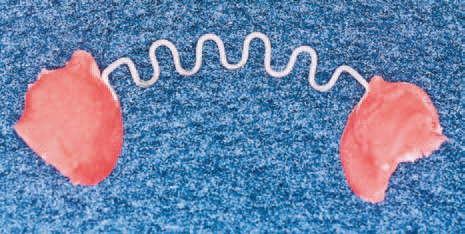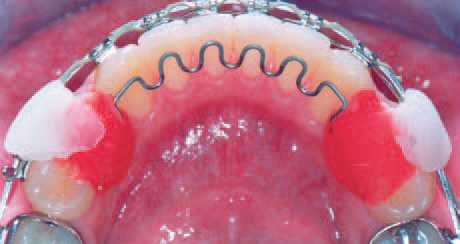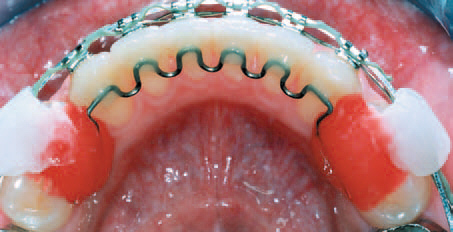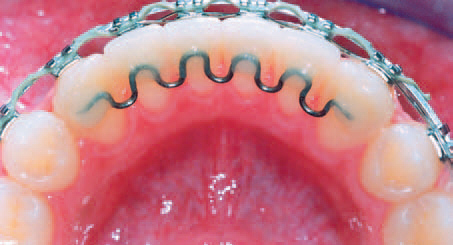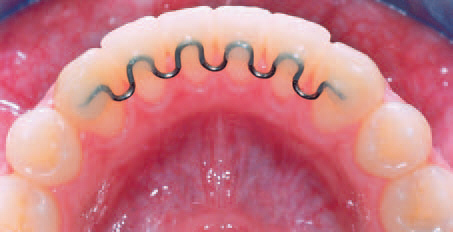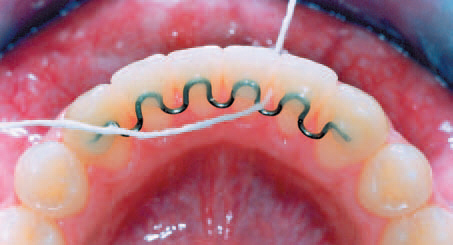Bonding a V-Loop Lingual Retainer with a DuraLay Transfer Trayl
Marilia Teixeira Costa, DDS,
Ms Marcos Auguso Lenza, DDS,
Ms, PhD Rosieide Santos Amorim-Brito, DDS, MS
Bonded lingual retainers have been developed with various wire sizes, designs, and placement methods. 1-6 Lew has described a directbonded lingual retainer made of multistranded wires in a simple V-loop configuration.2 The loops extend to the papilla of each retained tooth, allowing the patient to floss the interproximal gingival crevices without compromising periodontal health.
Any bonding technique carries the risk of moisture contamination, which can lead to bond failures and subsequently to relapse.7,8 Other problems with current retainer bonding methods include the length of chairtime required and the difficulty of precisely adapting the retainer wire to the lingual surfaces.
The present article proposes a modified technique for bonding a 3-3 V-shaped lingual retainer, using a DuraLay* transfer tray as suggested by Lee and colleagues.7 This time-saving method allows optimum moisture control and adaptation while providing the patient with adequate access for oral hygiene and permitting physiologic movements of the teeth during retention.
*Reliance Dental Manufacturing Co., 5805 W. 117th Place, Worth, IL 60482.
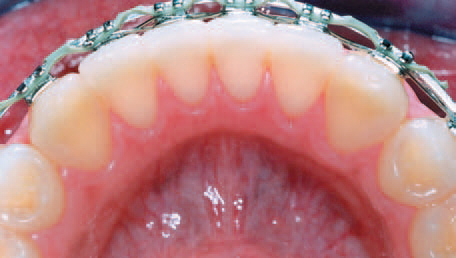
Fig. 1 Patient before fixed appliance removal.
| 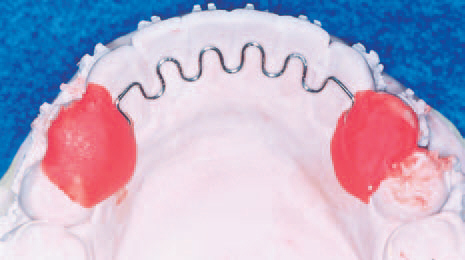
Fig. 3 Passive retainer wire attached to cast at both ends with DuraLay acrylic. |
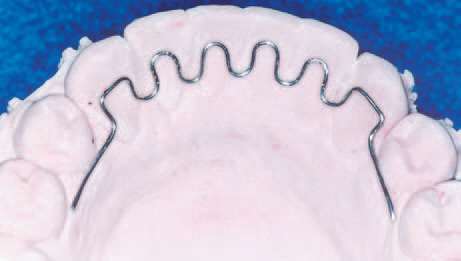
Fig. 2 .024" stainless steel wire adapted to
cast with V-bends at papillae and distal
extensions to first premolars.
| 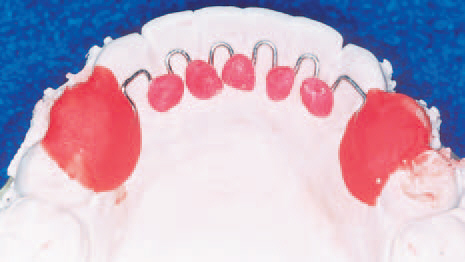
Fig. 4 Papillary wire surfaces covered with
utility wax. |
Drs. Costa and Amorim-Brito are Assistant Clinical Professors and Dr. Lenza is Director, Graduate Program in Orthodontics, School of Dentistry, University of Goiás, Brazil. Drs. Costa and Amorim-Brito are also in the private practice of orthodontics in Goiânia, Goiás, Brazil. Contact Dr. Costa at Rua 18, #110 Ed. Business Center, Sala 10, Setor Oeste, Goiânia, Goiás 74120-080, Brazil; e-mail: letlila@uol.com.br.
Procedure
- Before removing the fixed appliance, take an alginate impression of the anterior teeth, and pour it in hard stone (Fig. 1).
- Gently bend the retainer on the cast, following the contours of the lingual papillae in a “V” or “U” configuration. An .024" stainless steel wire will have greater resistance to fracture than multistranded wires9 and is smoother to the tongue.10 Extend the wire distally to the first premolars on both sides (Fig. 2). Apply a separating medium to the occlusal and lingual surfaces of the first premolars on the cast.
- Form the transfer tray from DuraLay, an acrylic that is easy to manipulate, requires little polymerization time, and has good dimensional stability. Attach each end of the retainer wire to the cast with DuraLay (Fig. 3). Passive contact with all the lingual surfaces of the anterior teeth is critical, because any tension in the wire may lead to failure.
- Cover the areas that will not be bonded—the V-bends contacting the papillae—with utility wax (Fig. 4). Sandblast the exposed wire surfaces with aluminum oxide to improve microretention and thus prevent bond failures within the adhesive and at the wire-adhesive interfaces11 (Fig. 5).
- Remove the retainer wire and transfer tray from the cast (Fig. 6).
- Prophy the lingual surfaces of the anterior teeth to be bonded. After etching the enamel and applying a liquid resin, position the retainer in the mouth, holding the DuraLay transfer tray in place with utility wax over the premolar brackets (Fig. 7).
- Cover the lingual surfaces and the sandblasted portions of the retainer wire with composite resin, taking care not to invade the papillae or the interproximal contact points (Fig. 8). For optimum strength and patient comfort, the composite coverage should be at least 1mm wherever possible. 12,13
- Once the composite has polymerized, cut the distal wire extensions at the premolars, being careful not to damage the enamel. Add composite to the distal ends of the retainer wire in the canine regions (Fig. 9).
- Remove the brackets and polish the buccal surfaces of the teeth only after the retainer is completely stable (Fig. 10). Use dental floss to check the retainer height and the interproximal spaces (Fig. 11).
References
- Shapiro, P.A. and Kokich, V.G.: The rationale for various modes of retention, Dent. Clin. N. Am. 25:177-193, 1981.
- Lew, K.K.K.: Direct-bonded lingual retainer, J. Clin. Orthod. 23:490-491, 1989.
- Iniguez, I. and Strassler, H.E.: Polyethylene ribbon and fixed orthodontic retention and porcelain veneers: Solving an esthetic dilemma, J. Esth. Dent. 10:52-59, 1998.
- Liou, E.J.W.; Chen, L.I.J.; and Huang, C.S.: Nickel-titanium mandibular bonded lingual 3-3 retainer: For permanent retention and solving relapse of mandibular anterior crowding, Am. J. Orthod. 119:443-449, 2001.
- Karaman, A.I.; Kir, N.; and Belli, S.: Four applications of reinforced polyethylene fiber material in orthodontic practice, Am. J. Orthod. 121:650-654, 2002.
- Bicalho, J.S. and Bicalho, K.T.: Descrição do método de contenção fixa com livre acesso do fio dental, R. Clin. Ortod. Dent. Press 1:9-13, 2002.
- Lee, S.J.; Ihm, J.A.; and Ahn, S.J.: Time-saving fixed lingual retainer using DuraLay resin transfer, Am. J. Orthod. 125:203- 205, 2004.
- Arnone, R.: Bonding orthodontic lower 3 to 3 retainers with a rubber dam: A second generation step-by-step procedure, Am. J. Orthod. 116:432-434, 1999.
- Artun, J.; Spadafora, A.T.; and Shapiro, P.A.: A 3-year followup study of various types of orthodontic canine-to-canine retainers, Eur. J. Orthod. 19:501-509, 1997.
- Zachrisson, B.U.: Third-generation mandibular bonded lingual 3-3 retainer, J. Clin. Orthod. 29:39-48, 1995.
- Lumsden, K.W.; Saidler, G.; and McColl, J.H.: Breakage incidence with direct-bonded lingual retainers, Br. J. Orthod. 26:191-194, 1999.
- Bearn, D.R.; McCabe, J.F.; Gordon, P.H.; and Aird, J.C.: Bonded orthodontic retainers: The wire-composite interface, Am. J. Orthod. 111:67-74, 1997.
- Cerny, R.: Permanent fixed lingual retention, J. Clin. Orthod. 35:728-732, 2001.

